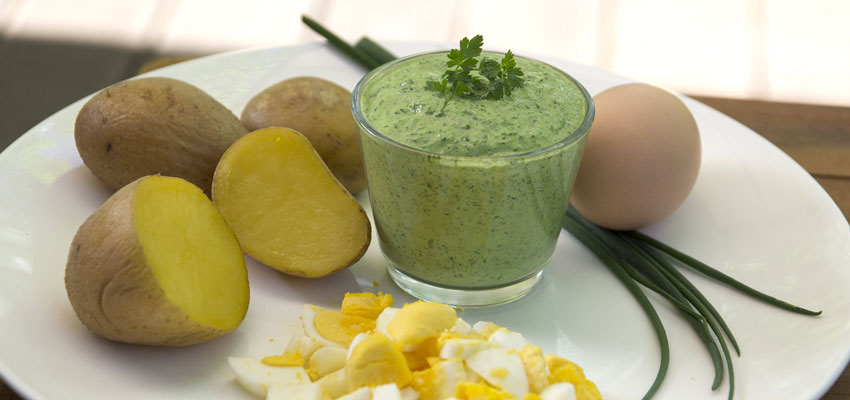The latest EU proposal provides for different maximum levels depending on the type of herb. If the members of the responsible SCoPAFF 1) of the EU Commission agree on 23.6. in their next meeting, the new limits could already apply in July.
The following information is taken from the draft version of the Regulation and is provisional, therefore it should be regarded as indicative only. In addition, some EU countries have already adopted stricter national regulations in the meantime. Belgium, for example, prohibited the use of borage in food, which in Germany is one of the 7 fresh herbs of the famous Frankfurt "Green Sauce" and it would be hard to imagine the regional speciality as an important flavour component without it.
|
|
|
Maximum Level (*) |
|
8.4.1 |
Herbal infusions (dried product) (**) (***) with the exception of herbal infusions refferred to in 8.4.2 and 8.4.4 |
200 |
|
8.4.2 |
Herbal infusions exclusively composed of Rooibos, Anise (Pimpinella anisum), Lemon balm, Chamomile (Matricaria chamomilla), thyme, peppermint, Lemon verbena (dried product) (**) (***) with exception of the herbal infusions referred to in 8.4.4 |
400 |
|
8.4.3 |
Tea (Camellia sinensis) and flavoured tea (****)(Camellia sinensis) (Dried product) (***) with the exception of tea and flavoured tea referred to in 8.4.4 |
150 |
|
8.4.4 |
Tea (Camellia sinensis) and flavoured tea (****)(Camellia sinensis) and herbal infusions for infants and young children (dried product) |
75 |
|
8.4.5 |
Tea (Camellia sinensis), flavoured tea (****) and herbal infusions for infants and young children (liquid) |
1.0 |
|
8.4.6 |
Food supplements containing herbal ingredients (**) (****) with the exception of food supplements referred to in 8.4.7 |
400 |
|
8.4.7 |
Pollen based food supplements (39), Pollen and pollen products (39) |
500 |
|
8.4.8 |
Borage (fresh, frozen) placed on the market for the final consumer (**) |
750 |
|
8.4.9 |
Dried herbs with the exception of dried herbs referred to in 8.4.10 (**) |
400 |
|
8.4.10 |
Dried herbs exclusively composed of borage, lovage, marjoram and oregano (dried) |
1000 |
|
8.4.11 |
Cumin seeds (seed spice) |
400 |
(*) The maximum level refers to the lowerbound sum of the following 21 pyrrolizidine alkaloids:
- Intermedine/lycopsamine, and their N-oxides
- Sencionine/senecivernine and their N-oxides
- Seneciphyllin and its N-oxide
- Retorsine and its N-oxide
- Echimidine and its N-Oxide
- Lasiocarpin and its N-Oxide
- Senkirkine
- Europine and its N-Oxide
- Heliotrine and its N-Oxide
And the following additional 14 pyrrolizidine alkaloids known to co-elute with one or more of the above identified 21 pyrrolizidine alkaloids, making use of certain currently used analytical methods:
- Indicine, Echinatine, Rinderine (possible co-elution with Intermedine/Lycopsamine),
- Indicine-N-oxid, Echinatine-N-oxide, Rinderine-N-oxide (possible co-elution with Intermedine-N-oxide /Lycopsamine-N-oxide)
- Integerrimine (possible co-elution with Sencionine/Senecivernine)
- Intergerrimine-N-oxide (possible co-elution with Sencionine-N-oxide /Senecivernine-N-oxide)
- Heliosupine (possible co-elution with Echimidine)
- Heliosupine-N-oxide (possible co-elution with Echimidine-N-oxide)
- Spartioidine (possible co-elution with Seneciphyllin)
- Spartioidine-N-oxide (possible co-elution with Seneciphyllin-N-oxide)
- Usaramine (possible co-elution with Retorsine)
- Usaramine-N-oxide (possible co-elution with Retorsine-N-oxide)
Given that these 14 pyrrolizidine alkaloids are possibly co-eluting the are not to be individually and separately identified and quantified. In case that these pyrrolizidine alkaloids or some of them can be individually and separately identified with the used method of analysis, they shall be quantified and included in the sum
(**) without prejudice to more restrictive national rules in certain Member States on the placing on the market of pyrrolizidine alkaloid containing plants
(***) the terms “herbal infusions (dried product)” and “Tea (Camellia sinensis), (dried product)” refer to
- dried herbs/tea (in sachets or in bulk) used for he preparation of herbal tea/tea
- instant herbal teas/teas. In case of powdered tea extracts, a concentration factor of 4 has to be applied
(****) flavoured tea is tea with flavourings and certain food ingredients with flavouring properties, as defined in Regulation (EC) No 1334/2008 of the European Parliament and the Council of 16 December 2008 on flavourings and certain food ingredients with flavouring properties for use in and on foods (OJ L 354 31.12.2008, p.34
For teas with fruits and other herbs, the provisions of article 2 of Regulation (EC) 1881/2006 apply
(*****) Herbal ingredients include extracts from Camellia sinensis
Where are pyrrolizidine alkaloids found?
Pyrrolizidine alkaloids (PA) are an extensive group of secondary plant ingredients, which can be found, for example, in herbal teas and dried seasoning herbs, plant extracts that can enter the respective product through non-sorted herbs. These compounds have also been detected in certain types of honey.
The PAs are classified as genotoxic and carcinogenic, which is why an EU maximum limit has been planned since 2017.
As a rule, 21 relevant representatives are now analytically recorded and shown as a sum total. However, there are still certain contradictions with regard to the assessment.
AGROLAB LUFA is currently developing an internal multi-method for the reliable and legally compliant determination of these compounds in the above-mentioned matrices. Until the method has received final approval, your samples will be examined by an accredited partner laboratory on a subcontract basis.
1) Standing Committee on Plants, Animals, Food and Feed (Novel Food and Toxicological Safety)
Author: Dr. Frank Mörsberger

 Contact
Contact

 Contact
Contact Career
Career